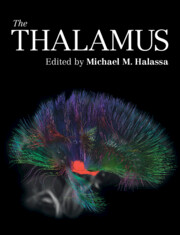Book contents
- The Thalamus
- The Thalamus
- Copyright page
- Contents
- Contributors
- Preface
- Section 1: History
- Section 2: Anatomy
- Chapter 2 Organization of Thalamic Inputs
- Chapter 3 Thalamic Output Pathways
- Chapter 4 Thalamocortical Circuitry Matters
- Section 3: Evolution
- Section 4: Development
- Section 5: Sensory Processing
- Section 6: Motor Control
- Section 7: Cognition
- Section 8: Arousal
- Section 9: Computation
- Index
- References
Chapter 3 - Thalamic Output Pathways
from Section 2: - Anatomy
Published online by Cambridge University Press: 12 August 2022
- The Thalamus
- The Thalamus
- Copyright page
- Contents
- Contributors
- Preface
- Section 1: History
- Section 2: Anatomy
- Chapter 2 Organization of Thalamic Inputs
- Chapter 3 Thalamic Output Pathways
- Chapter 4 Thalamocortical Circuitry Matters
- Section 3: Evolution
- Section 4: Development
- Section 5: Sensory Processing
- Section 6: Motor Control
- Section 7: Cognition
- Section 8: Arousal
- Section 9: Computation
- Index
- References
Summary
Projection neurons are both the main target of inputs to the thalamus and the only conduit for thalamic outputs. Projection neurons show similar somatodendritic morphologies, electrotonic properties, and membrane conductances, and they are all glutamatergic. Moreover, their axons never cross the midline and always target both the prethalamic reticular nucleus and one or more forebrain structures, chiefly the cerebral cortex and/or striatum. Despite these similarities, however, new anatomical, electrophysiological, and transcriptomic methods with single-cell resolution have in recent years revealed that thalamic projection neurons are remarkably diverse. Differences prominently involve axon arborization and gene-expression patterns, but significant variations in somatodendritic morphology and membrane conductances are also evident. Here, I first review the structural, functional, and gene-expression single-cell level variation observed among thalamic projection neurons. Then, based on evidence currently available for rodents, I propose a tentative catalog of six high-level cell classes. This catalog provides a consistent and cellularly accurate framework for the analysis of classic, large-scale thalamic output pathways such as the thalamocortical, thalamostriatal, and thalamoamygdaloid, among others. Moreover, developmental studies suggest that the neuron classes identified here may reflect a fundamental level of cell-lineage diversity that precedes nuclei formation or the establishment of thalamus connection systems.
- Type
- Chapter
- Information
- The Thalamus , pp. 45 - 70Publisher: Cambridge University PressPrint publication year: 2022

